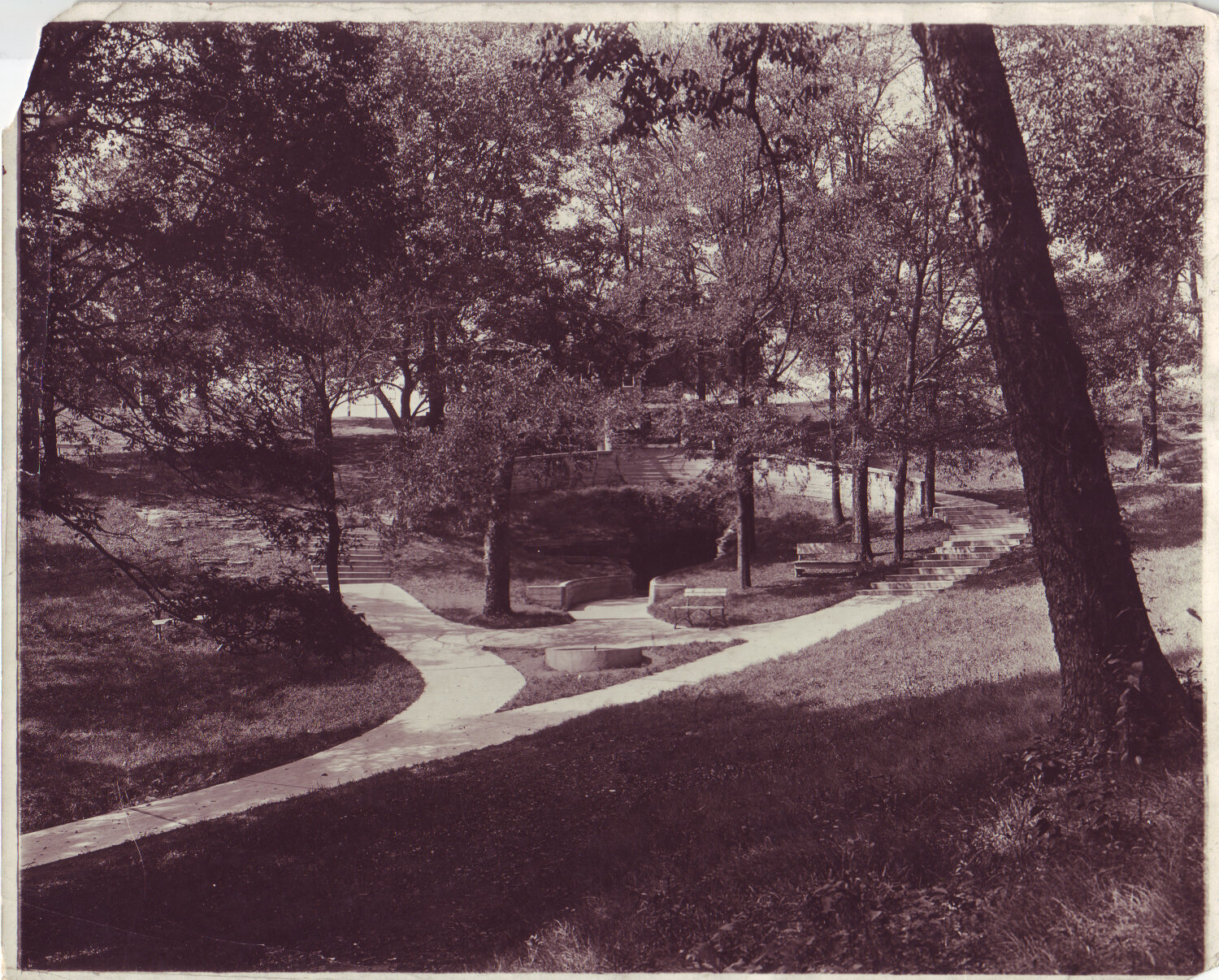
History of the park
Shelby Park I
As residents flocked to Nashville suburbs in the late 19th century, a local development company decided to acquire a large plot of plot of land in East Nashville to create a park (Cox 2016). The company developed the area into an amusement park, building an entertainment pavilion near the present-day community center. It would be called “Shelby Park”, after John Shelby: physician, Tennessee state senator, Nashville postmaster, East Nashville landowner, and military surgeon under Andrew Jackson in the Creek War of 1813 (Corgan 2018).
Formally opened in the summer of 1892, Shelby Park was advertised in The Tennessean as, “one of the prettiest parks in reach of the overheated public,” providing a cool morning and evening respite from the Tennessee summer (1892).
By the following summer, the park’s entertainment features were placed front and center. A bandstand was built to host local musicians and bands on Sunday afternoons. Such events drew an estimated 1500 to 2000 people each Sunday, including many Sunday school picnic groups (Cox 2016). Weekly performance s continued through the park’s early years, featuring jugglers, acrobats, dancers, rope walkers, and musicians. A newspaper article in The Daily American exemplifies the Park’s sensational entertainment lineup, reporting that on a Sunday in July, “the great lady aeronaut of Michigan,” Miss Lula Randall and her beloved poodle, each strapped with custom parachutes, would ascend in a balloon before leaping back to solid ground (1894).
As the new century approached and began, the park’s early energy began to dwindle, and the Edgefield Land Company entered tough financial straits. The large crowds and performances that characterized the Shelby Park of the 1890s slowly faded from reality. In 1908, after refusing several offers to buy the land, the park board of Nashville appointed an official to investigate acquiring the land for city use.
Shelby Park II
The following year, on September 15, an article in The Nashville American announced the public purchase of Shelby Park, highlighting the sentiment of the Park Commission’s Chairman that Shelby had, “every qualification for a splendid park for Greater Nashville” (1909). The article further relates that the Park board purchased the first 151 acres of the park from the creditors of the bankrupt land company for $40,000. This sale took a vast swath of private land of prime location and opportunity – near downtown Nashville and along the Cumberland River, with tracts of wooded, shady land boasting plentiful opportunity for fishing, swimming, and all other sorts of recreating – and transferred it to public hands, for the good of all. It would retain its original title of “Shelby Park.”
Shelby Park opened to the “public” on the 4th of July in 1912. As revealed by a MTSU Center for Historic Preservation report on park history, Shelby Park was opened for white members of the public. Hadley Park, opened on the same day in North Nashville, was opened for black people, beginning the long-lasting era of segregated public parks in Nashville (Van West et al. 2021). Though the Shelby Park Golf Course was desegregated in 1954 following Brown v Board of Education, the park system essentially remained segregated until at least 1962.
The park’s original featured included log shelters, a boathouse, windmill, cave spring grotto, and the sulfur spring shelter near the Lillian Avenue entrance. In 1924, Nashville’s first municipal golf course opened in Shelby Park. Another nine holes opened in 1932 and are now occupied by Vinny Links. The Park acquired an additional 60 acres in 1927 to help accommodate these developments (Kreyling 2012).
In 1961, the Shelby Park Community Center opened to the public, providing a space for community members to gather and recreate. The Community Center still serves as a vibrant gathering place, hosting students for its afterschool program as well as community events and various sports leagues and activities.
With the rise in team sports in the latter half of the century, many of the natural aspects of the park were traded for the addition of playing fields. With limited city resources, the historic features of Shelby Park fell into disrepair, decayed, and most were eventually torn down (Kreyling 2012). An injection of positive attention came to the park in the 1990s, and the green space we know today is due in great part to a significant development during this time.
Shelby Bottoms
Shelby Bottoms, a floodplain characterized by agriculture and swampland, faced potential destruction in the 1980s. The owners of the land proposed a swap: they would acquire the Shelby Golf Course to turn it into a development, while the city would acquire the Bottoms, which they could turn into a new golf course. East Nashville Residents quickly organized an emphatic opposition and quelled this proposition. Other ideas conceived by the landowners included dredging the bottoms to develop housing units along a “scenic parkway” or selling the property to a private landfill. These efforts would also prove fruitless for the developers.
Instead, in 1993, Nashville mayor Phil Bredesen purchased much of this land. Nashville’s first greenway was soon under construction in Shelby Bottoms (Wissner 1993, The Tennessean). Before long, Shelby Park and Bottoms collectively preserved more than 1000 acres of land for public use as parks.
In 2007, the Shelby Bottoms Nature Center opened, providing programming and information about the natural features of the surrounding land. The Nature Center and Shelby Bottoms collectively provide countless opportunities for Nashville residents to interact with and learn about native flora and fauna.
A few years later, Shelby Park and Bottoms would once again expand with the addition of Cornelia Fort Airpark.
Cornelia Fort Airpark
Cornelia Fort Airpark was established in 1945 on land adjacent to Shelby Bottoms, in honor of Cornelia Fort (1919-1943), an inspiring figure in early women’s aviation.
Fort was born and raised on the land that is now Cornelia Fort Airpark. An aviator, instructor (the first female instructor in Tennessee), and pioneer in women’s military aviation, Fort found herself giving flying lessons in the air over Honolulu on the morning of December 7, 1941, when a wave of Japanese Zeros swept past her. It was the bombing of Pearl Harbor. Luckily, she was able to land amidst a hailstorm of machine-gun fire. Thereafter, Cornelia Fort longed for service in the war effort and found it in 1942 when she and a handful of women were invited to become part of a new organization: the Women’s Auxiliary Ferrying Squadron (WAFS), which later became part of the Women’s Air Force Service Pilots (WASPS). She was part of a pioneering group of 28 women who established an excellent record of service and safety in the face of resistance from many quarters and less-than-ideal conditions. Unfortunately, while on a ferrying mission from California to Dallas in 1943, she was killed in a mid-air collision, making her the first American woman pilot to die in active military duty (Tennessee Encyclopedia of History & Culture).
More than 60 years after her death, the Airpark would retain its name after being purchased by the city of Nashville. Cornelia Fort Airpark was opened to the public as part of Shelby Bottoms in 2014. Today, community members may be found roller blading and cycling on the runway where Fort learned to fly.
Friends of Shelby Park and Bottoms
In 2008, a group of ardent community members formed Friends of Shelby Park and Bottoms to partner with the Metro Parks Department to manage, improve, and advocate for the park. For more information on our organization, visit our “About” page.
Sources:
“At Shelby Park,” The Daily American pg. 3. July 7, 1894. Accessed at https://nashvillehistory.blogspot.com/2016/09/the-first-shelby-park-1892-1905.html (Accessed September 22, 2022).
Cooley, Bobby, Alexis Matrone, David Britton, Dani O’Brien, and Dr. Carroll Van West. “Naval Reserve Training Center Shelby Park, Nashville Tennessee: Historical narrative, Preservation assessment, and Adaptive Reuse recommendations.” MTSU Center for Historic Preservation. May 2021.
Corgan, James X. “John Shelby (1785-1859).” Tennessee Encyclopedia, Tennessee Historical Society. Last edited March 1, 2018. https://tennesseeencyclopedia.net/entries/john-shelby/.
Cox, Debie Oeser. “The First Shelby Park, 1892-1905.” Nashville History. September 1, 2016. https://nashvillehistory.blogspot.com/2016/09/the-first-shelby-park-1892-1905.html.
Kreyling, Christine. “Shelby Park 100 and Counting.” The East Nashvillian. https://www.theeastnashvillian.com/shelby-park/ (Accessed March 23, 2022).
“The New Shelby Park.” The Tennessean pg. 9. July 24, 1892. Accessed via Newspapers, August 31, 2021, https://www.newspapers.com/image/603954016/?terms=shelby%3B%20park&match=1 (Accessed September 22, 2022).
“Purchase of Shelby Park.” The Nashville American pg. 7. September 15, 1909. https://www.newspapers.com/image/604202884/?terms=Shelby%20Park&match=1 (Accessed September 22, 2022).
Wissner, Sheila. “Mayor sees greenbelt as a beginning,” The Tennesean pg. 5B. July 3, 1993. https://www.newspapers.com/image/112544094/?terms=bredesen%3B%20shelby%20bottoms&match=1 (Accessed March 23, 2022).
